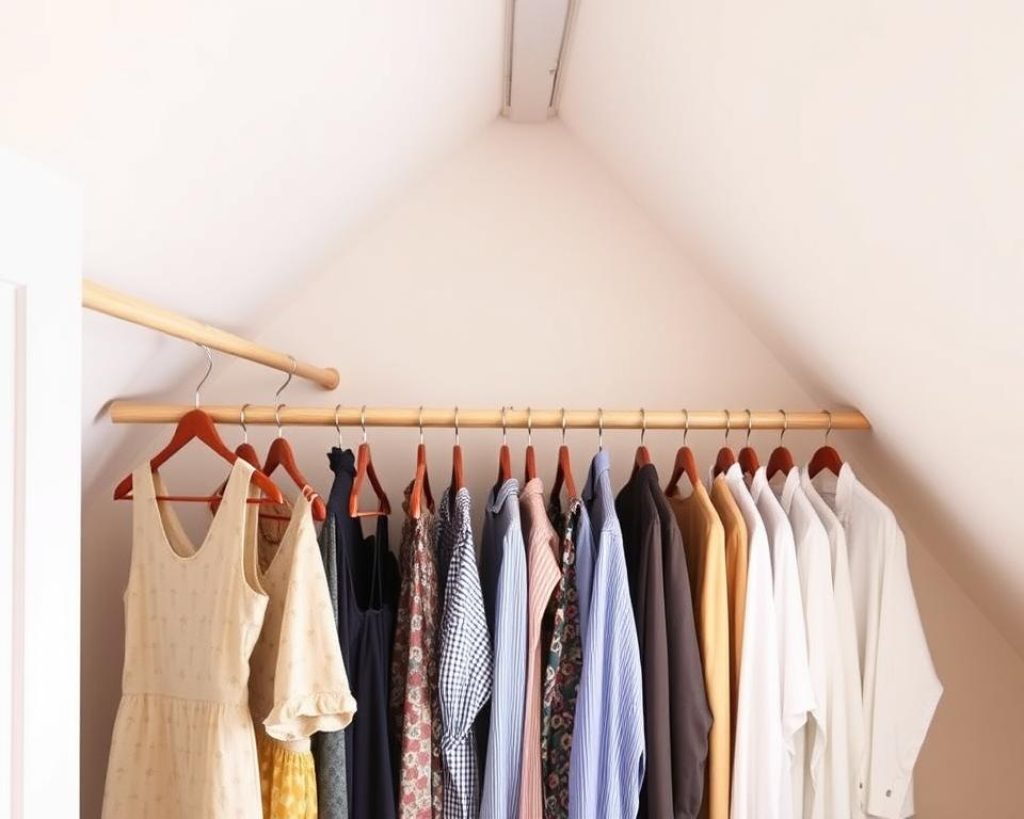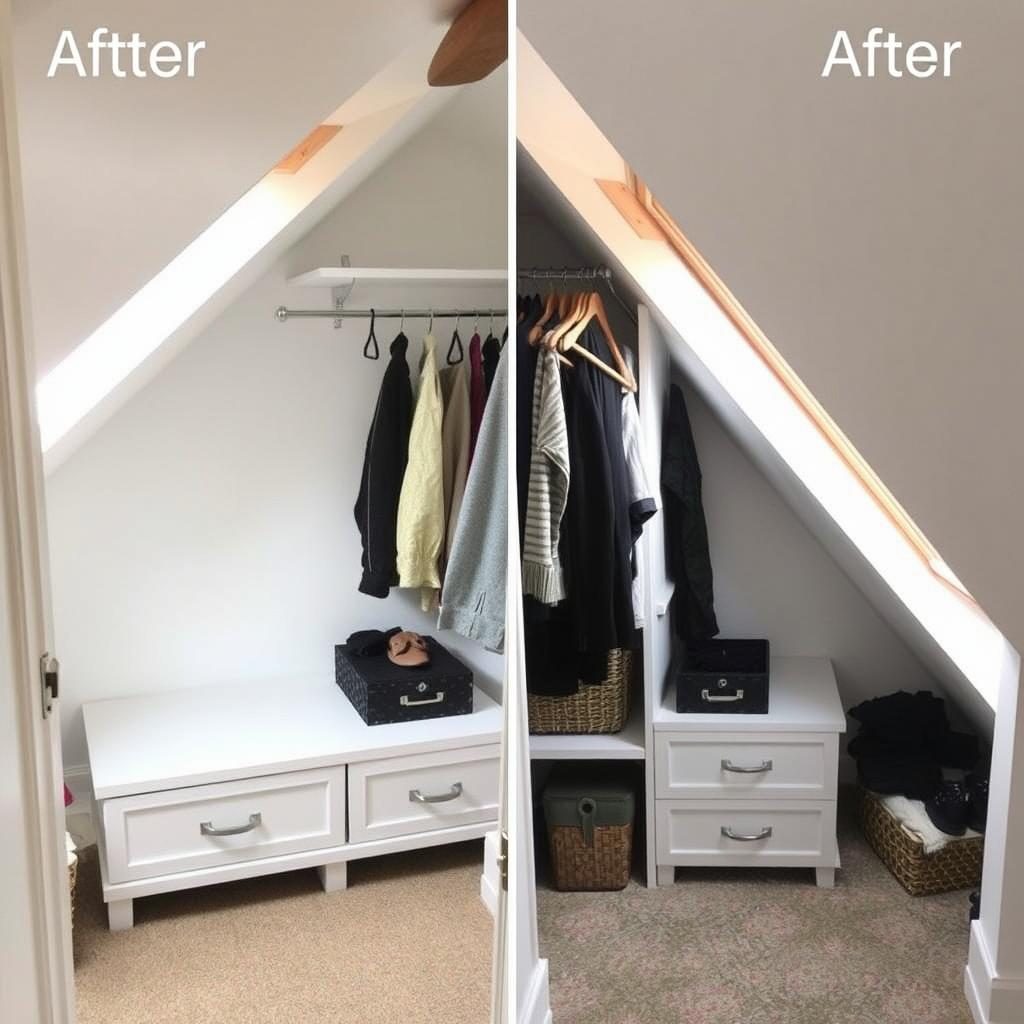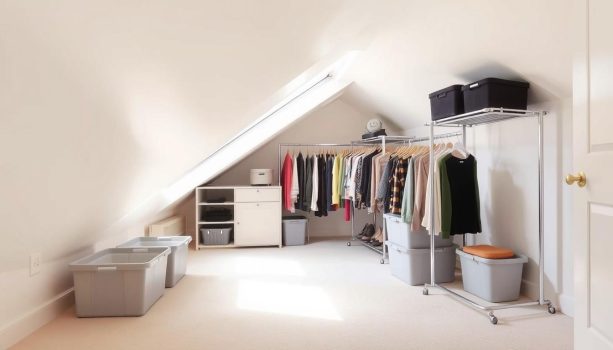Whether you’re looking to create a walk-in closet in your attic bedroom or simply need more organized storage space, we’ve gathered 15 innovative ideas that work with—not against—your attic’s unique structure.
Understanding the Challenges of Attic Closet Spaces
Before diving into specific ideas, it’s important to understand what makes attic closets unique. Unlike standard closets with straight walls and flat ceilings, attic spaces present several challenges:
- Slanted ceilings that limit vertical space
- Reduced headroom in many areas
- Awkward corners and nooks
- Limited wall space for standard closet systems
- Potential temperature fluctuations
The key to a successful attic closet is working with these features rather than fighting against them. Let’s explore solutions that transform these challenges into opportunities.
Custom Built-In Solutions for Slanted Ceilings
Custom built-ins are often the most effective way to maximize every inch of your attic space. These solutions are designed specifically for your attic’s dimensions and can be tailored to your storage needs.

1. Low-Profile Drawers Under Eaves
The space where your roof meets the floor is often too short for hanging clothes but perfect for drawers. Custom-built drawers that slide out from under the eaves make use of this otherwise wasted space.
2. Built-In Wardrobes Following Roof Lines
Custom wardrobes can be built to follow the exact angle of your roof, maximizing storage while maintaining a clean look. These can include a mix of hanging space, shelves, and drawers based on the available height.
3. Wall-to-Wall Shelving Systems
Custom shelving that spans from wall to wall creates a cohesive look while providing flexible storage. Adjust shelf heights based on ceiling clearance to maximize every inch.
Ready for a Custom Solution?
Professional closet designers can help you maximize every inch of your attic space with custom-built solutions tailored to your specific needs.
Get a Free Design Consultation
Modular and Adjustable Storage Systems
If custom built-ins aren’t in your budget, modular systems offer flexibility and can be adjusted to work with slanted ceilings.

4. Adjustable Track Systems
Track-based closet systems allow you to customize the height and placement of shelves, drawers, and hanging rods. This flexibility is perfect for working around slanted ceilings.
5. Stackable Storage Cubes
Modular storage cubes can be arranged to follow the line of your slanted ceiling. Place taller stacks where you have more headroom and shorter ones under the lowest parts of the ceiling.
6. Freestanding Wardrobes
Place freestanding wardrobes where you have adequate ceiling height. Look for options with adjustable shelving to maximize interior space.
| Storage System Type | Best For | Price Range | Installation Difficulty |
| Custom Built-ins | Maximizing every inch of space | $1,000-$5,000+ | Professional installation recommended |
| Track Systems | Flexibility and adjustability | $300-$1,200 | Moderate DIY project |
| Storage Cubes | Budget-friendly solutions | $100-$500 | Easy DIY assembly |
| Freestanding Wardrobes | No-installation options | $200-$1,000 | Simple assembly only |
Create Your Modular Attic Closet
The IKEA ALGOT system is perfect for slanted attic spaces with its adjustable components that can be configured to work with any ceiling height.
Shop Modular Storage Systems
Clever Hanging Solutions for Clothes Storage
Finding ways to hang clothes in an attic with slanted ceilings requires some creativity, but several effective solutions exist.

7. Multi-Level Hanging Rods
Install hanging rods at different heights to follow the slope of your ceiling. Use the tallest areas for dresses and long coats, and shorter areas for shirts and folded pants.
8. Ceiling-Mounted Hanging Systems
In areas with adequate height, install rods that hang from the ceiling rather than requiring wall support. These work well in the center of attic spaces.
9. Pull-Out Clothing Racks
Install pull-out racks that can be tucked away when not in use. These are perfect for areas with limited clearance but still provide accessible hanging space when needed.
Safety Tip
When installing any hanging system in an attic, be sure to secure it to studs or use appropriate anchors. The weight of clothing can be substantial, and proper installation is essential for safety.
Weight Considerations
Limit the weight on hanging rods in attics, especially if attached to slanted ceilings. Consider distributing heavier items like coats across multiple rods rather than concentrating them in one area.
Lighting Solutions for Dark Attic Closets
Proper lighting is essential in attic closets, which often lack natural light and have shadowy areas created by slanted ceilings.

10. LED Strip Lighting
Install LED strip lights along shelving edges or under cabinet areas to illuminate dark corners. These low-profile lights work well in tight spaces and can be powered by batteries or hardwired.
11. Recessed Lighting
For a clean look, install recessed lights in the ceiling. Position them strategically to illuminate your storage areas without creating shadows from the slanted ceiling.
12. Motion-Activated Lighting
Motion-sensor lights are perfect for attic closets, turning on automatically when you enter the space and off when you leave. This is especially useful in spaces you don’t access daily.
Illuminate Your Attic Closet
Battery-operated motion sensor LED lights are perfect for attic closets without existing wiring. They install in minutes and provide bright illumination exactly where you need it.
Multi-Functional Attic Closet Ideas
Make the most of your attic space by creating areas that serve multiple purposes. These ideas combine storage with other functions to maximize utility.

13. Closet-Office Hybrid
Combine clothing storage with a small workspace by installing a desk in an area with adequate headroom. Use the wall above for shelving that can hold both office supplies and folded clothing.
14. Dressing Area with Vanity
If space allows, include a small vanity with a mirror and stool to create a dressing area. Position it near a window if possible to take advantage of natural light.
15. Window Seat with Storage
If your attic has a window, build a window seat with storage drawers underneath. This creates a cozy spot to sit while adding valuable storage space.
“The best attic closets embrace the unique architecture rather than fighting against it. When you work with the angles and quirks, you can create something both beautiful and functional.”
Organization Tips for Attic Closets
Once you’ve created your attic closet, keeping it organized is key to maximizing its usefulness. These tips will help you maintain order in your new space.

Seasonal Rotation
Attics often experience temperature fluctuations, making them ideal for off-season storage. Rotate your wardrobe seasonally, keeping current items accessible and storing off-season clothes in protective containers.
Labeled Storage Bins
Clear storage bins with labels are essential for items stored in less accessible areas. This allows you to quickly identify contents without having to pull everything out.
Space-Saving Hangers
Slim velvet hangers take up less space than bulky plastic or wooden ones, allowing you to fit more items in limited hanging areas.
Organize Your Attic Closet
Clear storage bins with secure lids protect your clothing from dust and pests while keeping everything visible and organized.
Insulation and Climate Considerations
Attics can experience extreme temperatures that may affect your stored items. Proper insulation and climate control are important considerations for your attic closet.

Temperature Control
Consider adding insulation behind your closet systems to regulate temperature. If your attic gets very hot or cold, a small space heater or portable air conditioner might be necessary to protect delicate fabrics.
Humidity Management
Attics can be prone to humidity issues. Use dehumidifiers or moisture absorbers to protect clothing from mildew and musty odors, especially in areas with limited ventilation.
Safety Tip: If using any electrical appliances like dehumidifiers or space heaters in your attic closet, ensure proper ventilation and never leave them running unattended. Consider models with automatic shut-off features for added safety.
Before and After: Attic Closet Transformations
See how these homeowners transformed challenging attic spaces into functional, beautiful closets.

Before: Unused attic space with awkward angles and limited accessibility.

After: Custom built-ins that follow the roof line create organized storage while maximizing space.

Before: Small attic nook with severely slanted ceiling seemed unusable for storage.

After: Low drawers under the eaves and a hanging rod where height allows creates functional storage in a challenging space.
Frequently Asked Questions About Attic Closets
What is the minimum ceiling height needed for an attic closet?
For a functional attic closet, you’ll want at least 48 inches of height for hanging short items like shirts and pants. Areas with less height can still be used for drawers, shelves, or shoe storage. For a walk-in closet, aim for at least 72 inches of clearance in the center area to allow comfortable movement.
How do I insulate my attic closet to protect my clothes?
Proper insulation is crucial for attic closets. Consider adding insulation behind your storage systems using foam board or fiberglass insulation. Ensure your attic has adequate ventilation to prevent moisture buildup. For extra protection, use cedar blocks or lavender sachets to naturally repel moths and keep clothes fresh.
What’s the weight limit for attic floors when creating a closet?
Standard attic floors in modern homes can typically support 10-30 pounds per square foot for storage. However, this varies greatly depending on your home’s construction. Before installing heavy storage systems or filling your attic closet with items, consult a structural engineer to assess your specific situation. Distributing weight evenly is also important to prevent stress on any single area.
How can I add lighting to my attic closet if there’s no existing wiring?
Battery-operated LED lights are an excellent solution for attics without existing wiring. Options include puck lights, strip lights, and motion-sensor lights that can be installed without an electrician. For a more permanent solution, consider hiring an electrician to extend wiring to your attic space, which will provide more reliable and powerful lighting options.
Transform Your Attic into the Perfect Closet
With these 15 clever attic closet ideas, you can transform even the most challenging slanted ceiling space into an organized, functional storage area. By embracing your attic’s unique architecture and implementing solutions designed specifically for angled spaces, you’ll gain valuable storage while adding character to your home.
Remember that the best attic closets combine practical storage solutions with thoughtful design elements like proper lighting, climate control, and organization systems. Whether you opt for custom built-ins or modular components, your new attic closet can become one of your home’s most useful and unique features.
Ready to Plan Your Attic Closet?
Download our free attic closet planning guide with measurement templates, material checklists, and step-by-step instructions.
Download Free Planning Guide

